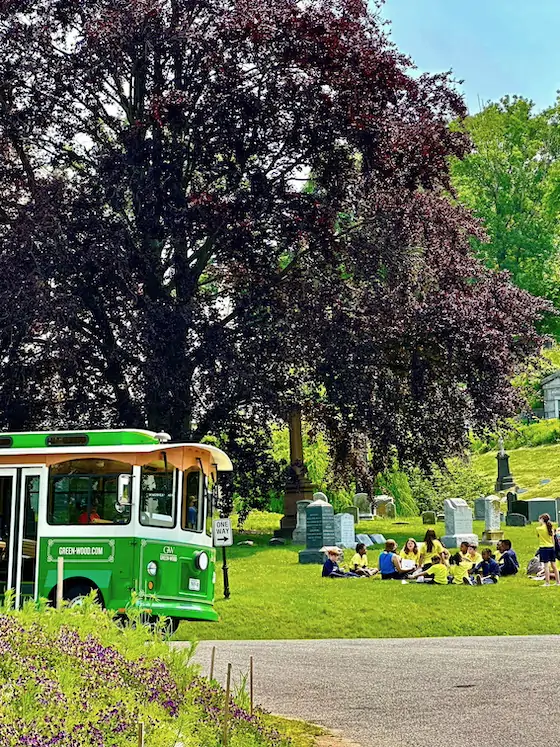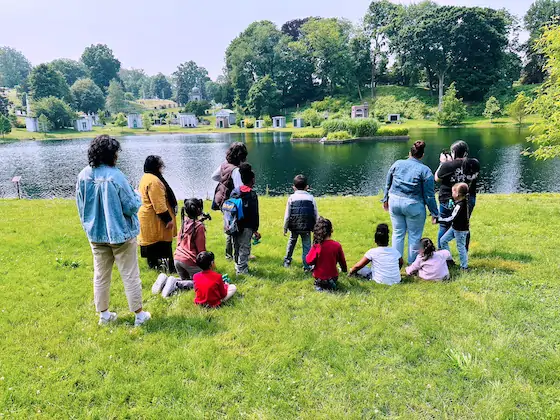Visiting a cemetery is a unique experience that can evoke a range of emotions, assumptions, memories, and questions, whether or not a person has experienced loss. Please use the materials on this page to prepare yourself, your students and their families, and your school administrators before your visit to Green-Wood.
Pre-Visit Letter for Families
We’ve consulted with world-renowned children’s grief expert Dr. David Schonfeld to create a customizable letter teachers can send home to families to help them understand what to expect from a Green-Wood school program. We recommend sending this letter (Available in English and Spanish) home at least one week prior to your Green-Wood program.
Pre-Visit Presentation
These slides (available only in English at this time) are designed to introduce your students to Green-Wood, gauge their feelings and questions about cemeteries, and go over rules for safety and respect before you arrive.

Supporting Grieving Students

- We encourage teachers to modify and share the letter linked above with ALL students’ families in advance of your Green-Wood school program.
- If any of your students have experienced the loss of a special person or pet even years in the past we recommend checking in with them and their support networks individually and privately before doing any Green-Wood program or pre-visit activity.
- If grieving students plan to attend the Green-Wood school program, you might consider:
- Asking them to review the pre-visit slides on this page at home with their loved ones before watching it in class, so they can process their feelings at home with family first.
- Creating a plan for the student to signal you if they are uncomfortable during a Green-Wood field trip or virtual program. If accompanied by an adult chaperone, students may sit near a Green-Wood entrance if they feel unable to participate in the program once on site.
- Providing an alternative project or assignment for the student if they and their support network decide not to participate in the Green-Wood program.
- For resources about grief sensitivity training, see:
For information about child development and grief, check out this recording of a recent virtual public program called “How to Talk to Kids About Death” co-hosted by Green-Wood and Park Slope Parents, featuring pediatric neuropsychologist Dr. Preeti Saigal.
Student FAQ:
What Kids Ask Us about Death and How We Answer

Green-Wood has been leading school groups through its grounds since 2006; we’ve heard and been asked it all! Our educators have also done work with children’s grief experts to come up with developmentally appropriate language around the Cemetery and death-related subjects that may arise during a program. Here’s how we respond to common student questions about death, burial, and mourning. We invite you to use this language as well!
If your students have questions before the program that aren’t on this list and you want a Green-Wood educator to answer them, email education@green-wood.com to inquire about a free, 15-minute, virtual, in-class Q&A with Green-Wood’s director of education, Rachel Walman.
Some guiding principles we follow:
- We answer students’ questions honestly and with direct language but without offering more information than the student asked for.
- We believe questions about personal religious beliefs or ideas about the afterlife are best discussed between students and their families. Green-Wood educators may share factual information about religious practices that are evident in the Cemetery (examples: explaining symbols on grave monuments, or objects left near graves), but they do not validate one belief system over another.
Are there really dead people in the ground here?
Yes. Cemeteries are designed for living people to visit their loved ones who are interred here.
Are we going to see dead people here?
No, we are not. Dead bodies are never out in the open here.
Are we going to a funeral?
No. Funerals are very personal and private events. If we see a funeral in the distance, we’ll quietly go the other way.
What are all these stone things?
We call them monuments. Some people call them gravestones or tombstones, which are types of monuments. Grave monuments are memorials to peoples’ lives.
Are there zombies/ghosts here?
Well, people have many different beliefs about what happens after death, but it’s important that you know that dead people cannot come back to life and cannot hurt you. We won’t be talking about zombies or ghosts in this school program.
What happens after you die? Like to your soul?
People have different beliefs about what happens after death. That’s a great question to discuss with your friends and family.
What happens after you die? Like, to your body?
When any living creature dies, all the parts of their body stop working and break down in a process called decomposition. It’s a hard process to explain in a short time. It’s a great topic to research at school or at home, but it’s not what today’s program is about. I’m going to get back to [the topic of our program] now.
I just saw a baby’s/child’s grave. Can kids die? I’m really upset.
I can understand why you’re feeling upset. It’s much less common today than in the past for children to die, but it does happen sometimes, and it’s totally ok for you to express your feelings about that here. You are safe here. Do you need to talk more to a grown up you trust?
If you or your students’ families have further questions, feel free to email education@green-wood.com.